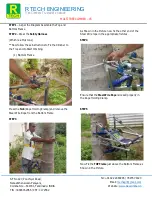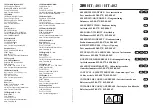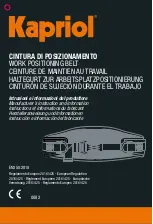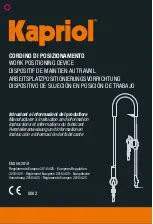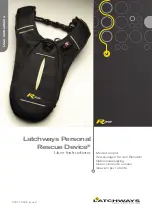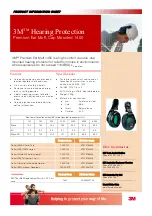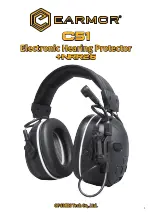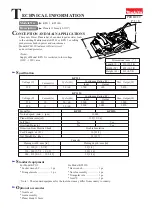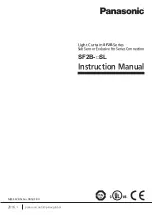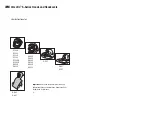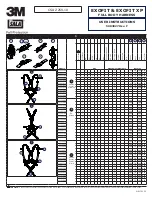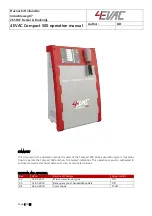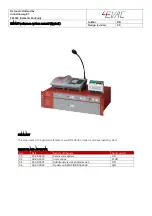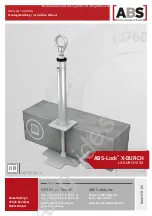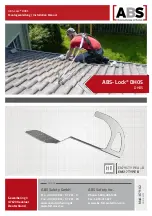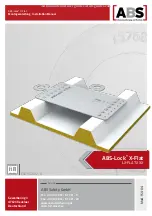
FR
4
1
5
8
10
12
11
2
3
7
6
9
FULL BODY HARNESS
Ref. 27905
Size:
S-L
XXL
COMBI
Date of manufacture:
MM.YYYY
Serial number:
XXX XXX
b
a
c
e
f
g
h
i
j
EN 358:2018
EN 361:2002
k
d
70 - 110 cm
l
3
EN 358
HOW TO PUT ON THE HARNESS
6
7
8
1
9
10
5
2
3
4
Take the harness by the back attaching
buckle.
Connect front plastic clip and adjust
the tension the chest strap.
Pull one and then other thigh straps
through crottch, take care do not twist
them.
Connecting of the steel buckles of the thigh straps and work positioning belt
Regulation of the thigh straps and work positioning belt
Put on the shoulder straps one after one,
take care do not twist them.
Shortening
Lengthening
THE ESSENTIAL PRINCIPLES FOR USERS OF PERSONAL PROTECTIVE EQUIPMENT AGAINST FALLS FROM A HEIGHT:
!
personal protective equipment shall only be used by a person trained and competent in its safe use.
!
personal protective equipment must not be used by a person with medical condition that could affect the safety of the equipment user in normal and emergency use.
!
a rescue plan shall be in place to deal with any emergencies that could arise during the work.
!
being suspended in PPE (e.g. arresting a fall), beware of suspension trauma symptoms.
!
to avoid symptoms of suspension trauma, be sure that the proper rescue plan is ready for use. It is recommended to use foot straps.
!
it is forbidden to make any alterations or additions to the equipment without the manufacturer's prior written consent.
!
any repair shall only be carried out by equipment manufacturer or his certified representative.
!
personal protective equipment shall not be used outside its limitations, or for any purpose other than that for which it is intended.
!
personal protective equipment should be a personal issue item.
!
before use ensure about the compatibility of items of equipment assembled into a fall arrest system. Periodically check connecting and adjusting of the equipment
components to avoid accidental loosening or disconnecting of the components.
!
it is forbidden to use combinations of items of equipment in which the safe function of any one item is affected by or interferes with the safe function of another.
!
before each use of personal protective equipment it is obligatory to carry out a pre-use check of the equipment, to ensure that it is in a serviceable condition and operates
correctly before it is used.
!
during pre-use check it is necessary to inspect all elements of the equipment in respect of any damages, excessive wear, corrosion, abrasion, cutting or incorrect acting,
especially take into consideration:
-
in full body harnesses and belts - buckles, adjusting elements, attaching points, webbings, seams, loops;
-
in energy absorbers - attaching loops, webbing, seams, casing, connectors;
-
in textile lanyards or lifelines or guidelines - rope, loops, thimbles, connectors, adjusting element, splices;
-
in steel lanyards or lifelines or guidelines - cable, wires, clips, ferrules, loops, thimbles, connectors, adjusting elements;
-
in retractable fall arresters - cable or webbing, retractor and brake proper acting, casing, energy absorber, connector;
-
in guided type fall arresters - body of the fall arrester, sliding function, locking gear acting, rivets and screws, connector, energy absorber;
-
in metalic components (connectors, hooks, anchors) - main body, rivets, gate, locking gear acting.
!
after every 12 months of utilization, personal protective equipment must be withdrawn from use to carry out periodical detailed inspection. The periodic inspection must be
carried out by a competent person for periodic inspection. The periodic inspection can be carried out also by the manufacturer or his authorized representative.
!
in case of some types of the complex equipment e.g. some types of retractable fall arresters the annual inspection can be carried out only by the manufacturer or his
authorized representative.
!
regular periodic inspections are the essential for equipment maintenance and the safety of the users which depends upon the continued efficiency and durability of the
equipment.
!
during periodic inspection it is necessary to check the legibility of the equipment marking. Don’t use the equipment with the illegible marking.
!
it is essential for the safety of the user that if the product is re-sold outside the original country of destination the reseller shall provide instructions for use, for
maintenance, for periodic examination and for repair in language of the country in which the product is to be used.
!
personal protective equipment must be withdrawn from use immediately when any doubt arise about its condition for safe use and not used again until confirmed in writing
by equipment manufacturer or his representative after carried out the detailed inspection.
!
personal protective equipment must be withdrawn from use immediately and destroyed (or another procedures shall be introduced according detailed instruction from
equipment manual) when it have been used to arrest a fall.
PERIODIC INSPECTIONS
Safety harness must be inspected at least once every 12 months from
the date of first use. Periodic inspections must only be carried out by a
competent person who has the knowledge and training required for
personal protective equipment periodic inspections. Depending upon
the type and environment of work, inspections may be needed to be
carried out more frequently than once every 12 months.
MAXIMUM LIFESPAN OF THE EQUIPMENT
The maximum lifespan of the harness is 10 years from the date of
manufacture.
ATTENTION: The harness maximum lifetime depends on the intensity
of usage and the environment of usage. Using the harness in rough
environment, marine environment, contact with sharp edges, exposure
to extreme temperatures or aggressive substances, etc. can lead to the
withdrawal from use even after one use.
WITHDRAWAL FROM USE
The harness must be withdrawn from use immediately and destroyed
when it has been used to arrest a fall or it fails to pass inspection or
there are any doubt as to its reliability.
Every periodic
inspection must be recorded in the Identity Card of the equipment.
1.1
1.2
2.1
2.2
1.3
ATTACHING FALL ARRESTS SYSTEMS – EN361
Fall arrest system can be attached only to the fall arrest attachment point of full body harness EN 361 marked with capital letter A:
- directly to the back D-ring (1.1)
- to the front attachment loops. The loops marked with a half of letter must be linked together when attached to the fall arrest
system (1.2). It is strictly forbidden to attach a fall arrest system to a single loop with a half of letter A (1.3).
Harness is put on correctly if:
-
All straps are correctly adjusted (neither too loose nor too tight).
-
Dorsal attachment D-ring is correctly positioned at the shoulder blades.
-
The ends of the all straps are secured with flexible loops.
NOTE: Before using the belt for the first time
the user should carry out a suspension test
in a safe place to ensure that the sit harness
has correct size, is properly adjusted and is of an
acceptable comfort level for the intended use.
It’s important to check the sit harness regularly
for any damage.
WARNING!
It is strictly forbidden to attach any fall arrest system to lateral buckle of the work positioning belt during work.
ATTACHING WORK POSITIONING/RESTRAINT SYSTEM (EN 358)
- waist belt should not be used if there is a foreseeable risk of the user becoming
suspended or being exposed to unintended tension by the waist belt
- when using a work positioning system, the user normally relies on the equipment for
support, therefore it is essential to consider the need of using a back-up, e.g. a fall arrest
system
- Work positioning or restraint system can be attached to lateral buckles of the work
positioning belt (3)
- Work positioning lanyard must be attached on a structural point located at the user's
waist or above and kept taut.
A/2
A/2
A/2
2.1
2.3
CONNEXION DE SYSTÈMES ANTICHUTE – EN361
Les systèmes de protection contre les chutes de hauteur ne peuvent être connectés qu’aux points
d’attelage marqués de la lettre A majuscule sur le harnais EN 361 :
- directement à l’anneau en D arrière (1.1)
- aux nœuds de connexion avant. Les nœuds marqués de la moitié d’une lettre (A/2) doivent
être reliés entre eux lors de la connexion d’un système antichute (1.2). Il est strictement interdit
de connecter un système antichute à un seul nœud marqué d’une moitie de la lettre (A/2) (1.3).
CONNEXION D’UN SYSTÈME DE RETENUE / DE MAINTIEN AU TRAVAIL (EN 358)
- Le système de retenue ou de maintien au travail peut être connecté aux boucles latérales de la
ceinture de maintien au travail (2.1)
- La sangle de maintien au travail doit être attachée sur un point structurel se situant au niveau de
la ceinture de l’utilisateur ou plus haut et doit rester tendue (2.2 et 2.3).
- la ceinture à la taille ne doit pas être utilisée s’il existe un risque prévisible que l’utilisateur se
retrouvera suspendu ou qu’il sera exposé à une tension indésirable
- pendant l’utilisation d’un système de maintien au travail, l’utilisateur s’appuie sur l’équipement
pour le support, il est donc essentiel de prendre en compte l’utilisation d’un deuxième système de
sécurité, tel qu’un système antichute
AVERTISSEMENT !
Il est strictement interdit de connecter un quelconque système de protection contre les chutes de
hauteur aux boucles latérales de la ceinture de maintien au travail pendant le travail.
PRINCIPES DE BASE POUR LES UTILISATEURS D’ÉQUIPEMENTS DE PROTECTION CONTRE LES
CHUTES DE HAUTEUR:
• l’équipement de protection individuelle doit être utilisé uniquement par des personnes compétent-
es et formées en la matière.
• l’équipement de protection individuelle ne doit pas être utilisé par des personnes souffrant de
maladies pouvant affecter la sécurité de l’équipement et de l’utilisateur en conditions normales ou
en conditions d’urgence.
• un plan de sauvetage doit être mis en place pour pouvoir faire face à d’éventuelles urgences qui
pourraient se produire dans le cadre du travail.
• lors de la suspension en équipement de protection individuelle (ex. lorsqu’il a servi à arrêter une
chute), faites attention aux symptômes liés aux traumatismes causés par la suspension.
• pour éviter les traumatismes causés par la suspension, assurez-vous qu’un plan de sauvetage
approprié est prêt à être utilisé. Il est recommandé d’utiliser des sangles pour pieds.
• il est interdit d’effectuer une quelconque modification au niveau de l’équipement sans l’accord
préalable et écrit du fabricant.
• toute réparation doit être effectuée exclusivement par le fabricant de l’équipement ou par son
représentant dûment certifié.
• l’équipement de protection individuelle ne doit pas être utilisé en dehors de ses limites, ni à
aucune autre fin que celle qui a été prévue.
4
1
5
8
10
12
11
2
3
7
6
9
FULL BODY HARNESS
Ref. 27905
Size:
S-L
XXL
COMBI
Date of manufacture:
MM.YYYY
Serial number:
XXX XXX
b
a
c
e
f
g
h
i
j
EN 358:2018
EN 361:2002
k
d
70 - 110 cm
l
3
EN 358
HOW TO PUT ON THE HARNESS
6
7
8
1
9
10
5
2
3
4
Take the harness by the back attaching
buckle.
Connect front plastic clip and adjust
the tension the chest strap.
Pull one and then other thigh straps
through crottch, take care do not twist
them.
Connecting of the steel buckles of the thigh straps and work positioning belt
Regulation of the thigh straps and work positioning belt
Put on the shoulder straps one after one,
take care do not twist them.
Shortening
Lengthening
THE ESSENTIAL PRINCIPLES FOR USERS OF PERSONAL PROTECTIVE EQUIPMENT AGAINST FALLS FROM A HEIGHT:
!
personal protective equipment shall only be used by a person trained and competent in its safe use.
!
personal protective equipment must not be used by a person with medical condition that could affect the safety of the equipment user in normal and emergency use.
!
a rescue plan shall be in place to deal with any emergencies that could arise during the work.
!
being suspended in PPE (e.g. arresting a fall), beware of suspension trauma symptoms.
!
to avoid symptoms of suspension trauma, be sure that the proper rescue plan is ready for use. It is recommended to use foot straps.
!
it is forbidden to make any alterations or additions to the equipment without the manufacturer's prior written consent.
!
any repair shall only be carried out by equipment manufacturer or his certified representative.
!
personal protective equipment shall not be used outside its limitations, or for any purpose other than that for which it is intended.
!
personal protective equipment should be a personal issue item.
!
before use ensure about the compatibility of items of equipment assembled into a fall arrest system. Periodically check connecting and adjusting of the equipment
components to avoid accidental loosening or disconnecting of the components.
!
it is forbidden to use combinations of items of equipment in which the safe function of any one item is affected by or interferes with the safe function of another.
!
before each use of personal protective equipment it is obligatory to carry out a pre-use check of the equipment, to ensure that it is in a serviceable condition and operates
correctly before it is used.
!
during pre-use check it is necessary to inspect all elements of the equipment in respect of any damages, excessive wear, corrosion, abrasion, cutting or incorrect acting,
especially take into consideration:
-
in full body harnesses and belts - buckles, adjusting elements, attaching points, webbings, seams, loops;
-
in energy absorbers - attaching loops, webbing, seams, casing, connectors;
-
in textile lanyards or lifelines or guidelines - rope, loops, thimbles, connectors, adjusting element, splices;
-
in steel lanyards or lifelines or guidelines - cable, wires, clips, ferrules, loops, thimbles, connectors, adjusting elements;
-
in retractable fall arresters - cable or webbing, retractor and brake proper acting, casing, energy absorber, connector;
-
in guided type fall arresters - body of the fall arrester, sliding function, locking gear acting, rivets and screws, connector, energy absorber;
-
in metalic components (connectors, hooks, anchors) - main body, rivets, gate, locking gear acting.
!
after every 12 months of utilization, personal protective equipment must be withdrawn from use to carry out periodical detailed inspection. The periodic inspection must be
carried out by a competent person for periodic inspection. The periodic inspection can be carried out also by the manufacturer or his authorized representative.
!
in case of some types of the complex equipment e.g. some types of retractable fall arresters the annual inspection can be carried out only by the manufacturer or his
authorized representative.
!
regular periodic inspections are the essential for equipment maintenance and the safety of the users which depends upon the continued efficiency and durability of the
equipment.
!
during periodic inspection it is necessary to check the legibility of the equipment marking. Don’t use the equipment with the illegible marking.
!
it is essential for the safety of the user that if the product is re-sold outside the original country of destination the reseller shall provide instructions for use, for
maintenance, for periodic examination and for repair in language of the country in which the product is to be used.
!
personal protective equipment must be withdrawn from use immediately when any doubt arise about its condition for safe use and not used again until confirmed in writing
by equipment manufacturer or his representative after carried out the detailed inspection.
!
personal protective equipment must be withdrawn from use immediately and destroyed (or another procedures shall be introduced according detailed instruction from
equipment manual) when it have been used to arrest a fall.
PERIODIC INSPECTIONS
Safety harness must be inspected at least once every 12 months from
the date of first use. Periodic inspections must only be carried out by a
competent person who has the knowledge and training required for
personal protective equipment periodic inspections. Depending upon
the type and environment of work, inspections may be needed to be
carried out more frequently than once every 12 months.
MAXIMUM LIFESPAN OF THE EQUIPMENT
The maximum lifespan of the harness is 10 years from the date of
manufacture.
ATTENTION: The harness maximum lifetime depends on the intensity
of usage and the environment of usage. Using the harness in rough
environment, marine environment, contact with sharp edges, exposure
to extreme temperatures or aggressive substances, etc. can lead to the
withdrawal from use even after one use.
WITHDRAWAL FROM USE
The harness must be withdrawn from use immediately and destroyed
when it has been used to arrest a fall or it fails to pass inspection or
there are any doubt as to its reliability.
Every periodic
inspection must be recorded in the Identity Card of the equipment.
1.1
1.2
2.1
2.2
1.3
ATTACHING FALL ARRESTS SYSTEMS – EN361
Fall arrest system can be attached only to the fall arrest attachment point of full body harness EN 361 marked with capital letter A:
- directly to the back D-ring (1.1)
- to the front attachment loops. The loops marked with a half of letter must be linked together when attached to the fall arrest
system (1.2). It is strictly forbidden to attach a fall arrest system to a single loop with a half of letter A (1.3).
Harness is put on correctly if:
-
All straps are correctly adjusted (neither too loose nor too tight).
-
Dorsal attachment D-ring is correctly positioned at the shoulder blades.
-
The ends of the all straps are secured with flexible loops.
NOTE: Before using the belt for the first time
the user should carry out a suspension test
in a safe place to ensure that the sit harness
has correct size, is properly adjusted and is of an
acceptable comfort level for the intended use.
It’s important to check the sit harness regularly
for any damage.
WARNING!
It is strictly forbidden to attach any fall arrest system to lateral buckle of the work positioning belt during work.
ATTACHING WORK POSITIONING/RESTRAINT SYSTEM (EN 358)
- waist belt should not be used if there is a foreseeable risk of the user becoming
suspended or being exposed to unintended tension by the waist belt
- when using a work positioning system, the user normally relies on the equipment for
support, therefore it is essential to consider the need of using a back-up, e.g. a fall arrest
system
- Work positioning or restraint system can be attached to lateral buckles of the work
positioning belt (3)
- Work positioning lanyard must be attached on a structural point located at the user's
waist or above and kept taut.
A/2
A/2
A/2
2.1
2.3































